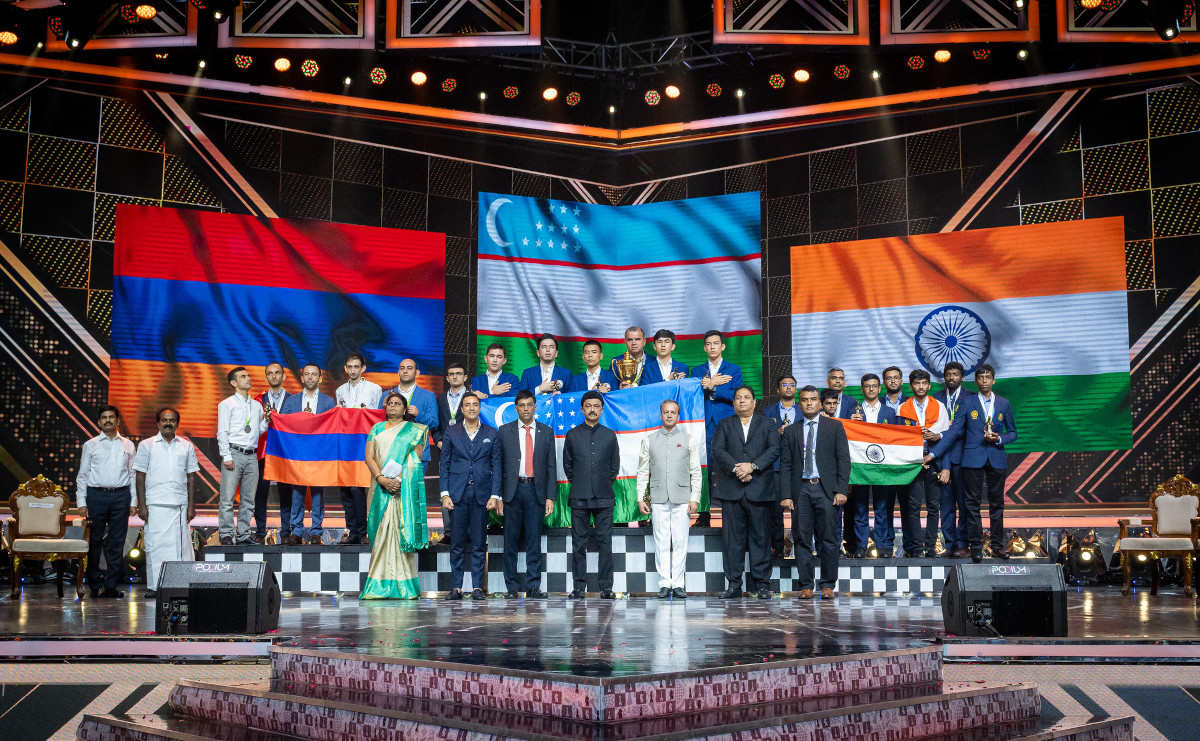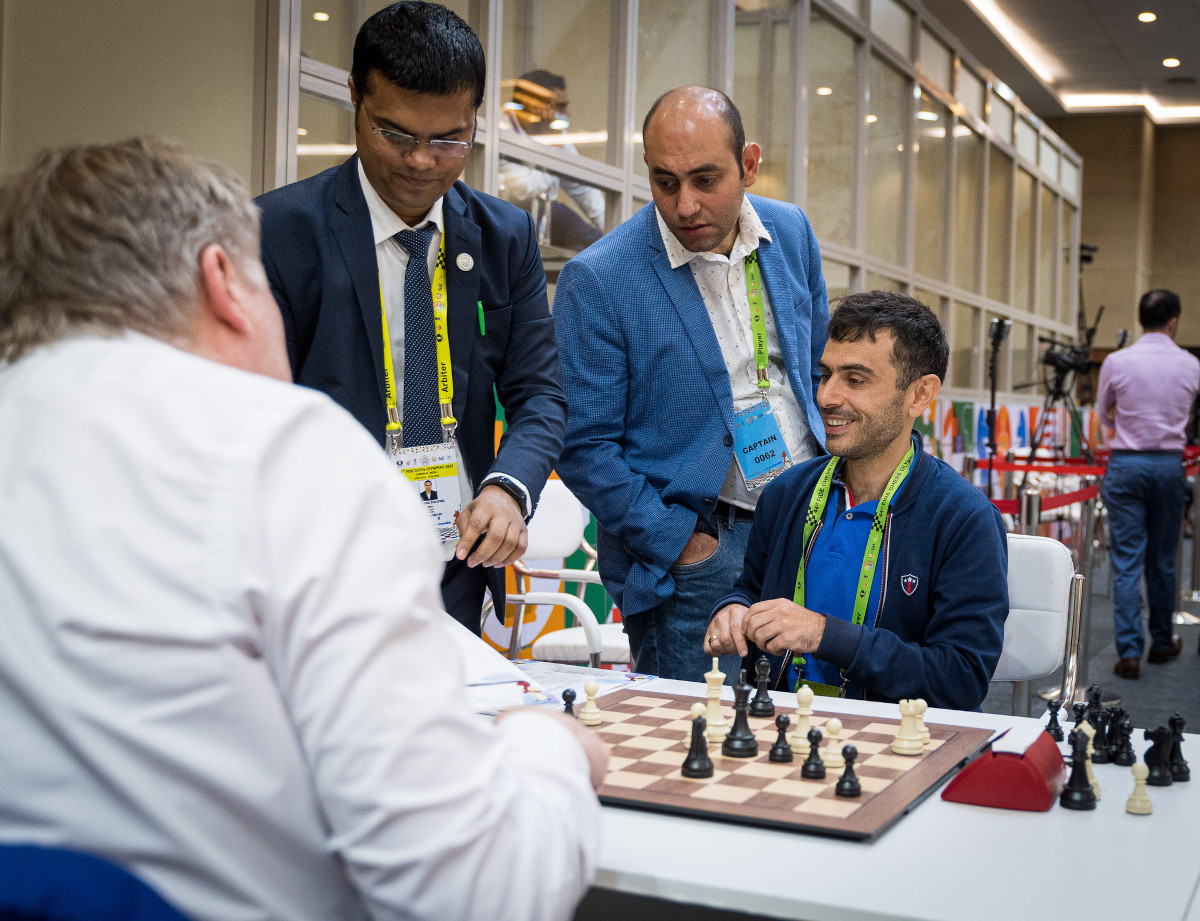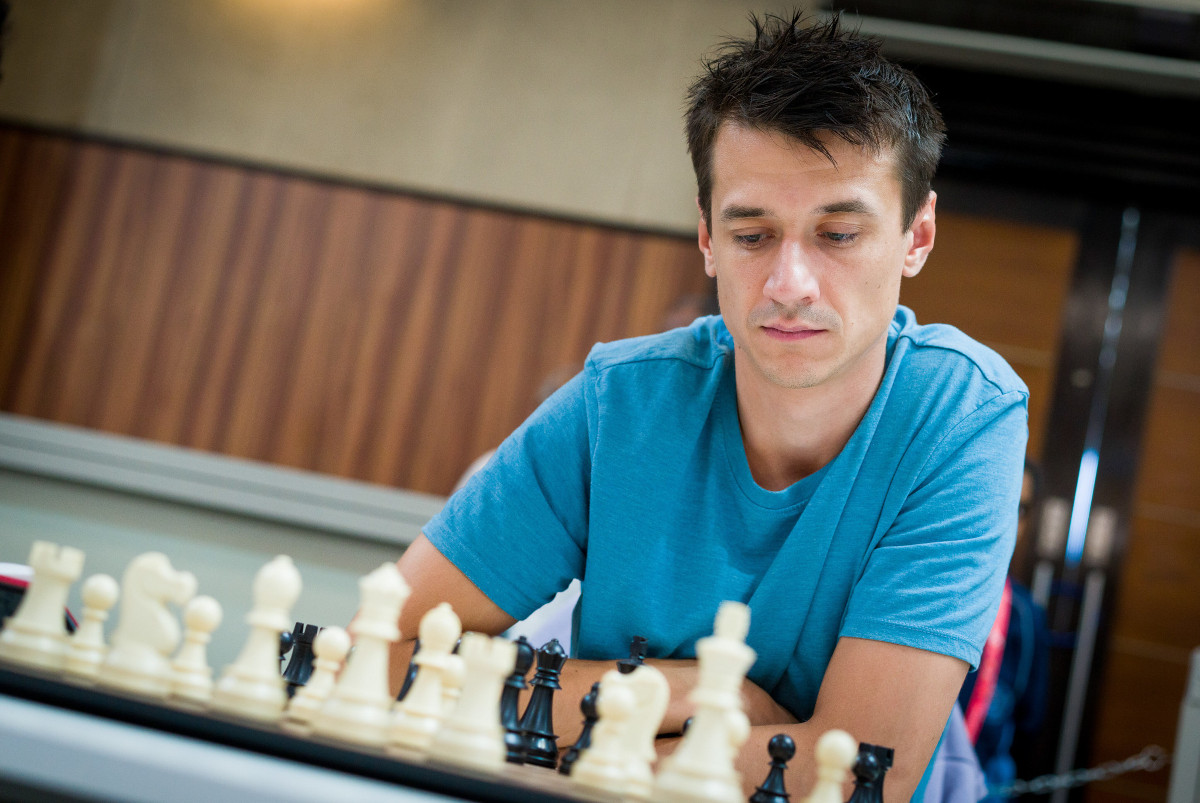


Ian Nepomniachtchi’s reflection regarding the importance of avoiding losses in the Candidates Tournament — which he won twice in a row — was also applicable in this year’s Chess Olympiad, as Uzbekistan, in the open, and Ukraine, in the women’s section, were the only teams that finished the tournament undefeated, and they took home gold medals in their respective categories.
The youthful squad from Uzbekistan scored 8 wins and 3 draws for a 19/22 score in the open. Armenia scored the same number of points, but had a markedly inferior tiebreak score. The team led by Gabriel Sargissian lost in round 9 against the eventual champions.
In the women’s section, the second seeds from Ukraine, with an experienced team which included two former women’s world champions, scored 7 wins and 4 draws for an 18/22 score. Much like in the open, another team tied with points with the champions but had an inferior tiebreak score. Georgia got silver, and its one defeat of the event was suffered in round 6, when they lost to India.

On the open tournament’s podium: Uzbekistan, Armenia and India 2 | Photo: Lennart Ootes
The host country, whose organization and enthusiasm was almost universally praised by the participants and the audience, saw two of its teams grabbing bronze medals. The incredibly young India 2 squad out-performed the ‘first team’ and got third place in the open, while the strong women’s team also got bronze in its section.
Given how things were going for the Indian teams that eventually made it to the podium, getting bronze in both sections surely left a bittersweet taste among the locals. A single blunder by Gukesh — who shocked the world by winning eight games in a row — prevented his team from beating Uzbekistan in round 10, while the Indian women never lost the lead (or the shared lead) until the final round.
Notwithstanding, we are sure to see more outstanding performances by Indian teams in the future. They are likely to fight for gold in many editions to come, as they have proven how effective junior development programs can be. And we can anticipate more talented youngsters to show up, given how successful this record-breaking Olympiad has been in Chennai!

The Indian teams | Photo: Lennart Ootes
The two teams that entered the final round tied for first place won their matches by the smallest of margins. Gabriel Sargissian (Armenia) and Jakhongir Vakhidov (Uzbekistan) were the heroes for their teams in the matches against Spain and the Netherlands, respectively.
Vakhidov beat Max Warmerdam to finish the tournament with an undefeated 6½/8 score on board 4 and an incredible 2813 performance rating. Vakhidov’s performance rating was only a bit higher than that of Nodirbek Abdusattorov on top board, who scored 8½/11 (there were no rest days for the 17-year-old) and a 2803 TPR!
Along the way, Vakhidov obtained an all-important win over Armenia’s Robert Hovhannisyan, while Abdusattorov kicked off the event with five consecutive victories, including a win with the black pieces over none other than Fabiano Caruana.
Vakhidov grabbed individual gold on board 4, while Abdusattorov took home silver for his individual performance on board 1.

Time to celebrate — Ivan Sokolov and Jakhongir Vakhidov | Photo: Lennart Ootes

Boards 1 and 2 of the winning team — Nodirbek Abdusattorov (aged 17) and Nodirbek Yakkuboev (20) | Photo: Lennart Ootes
As for the Armenians, who for the first time played without their long-time leader Levon Aronian, it was all about Sargissian stepping up in the final rounds. The 38-year-old had a quiet start, as he collected four draws and a loss in the first six rounds. From rounds 7 to 11, however, he scored 4½/5 points, with wins over Caruana, Pentala Harikrishna, Shakhriyar Mamedyarov and Alexei Shirov!
Shirov’s 15...g6, allowing a bishop fork, turned out to be a decisive mistake. The in-form Sargissian found all the right moves to punish the Spaniard’s mistake.
Over 17 minutes were spent on 15...g6, so we know Shirov was calculating the consequences of 16.Bg5. The man from Riga figured out that 16...Qh5 was the strongest continuation, attacking the pawn on f3 and threatening ...Bh6 if White grabs the rook on d8.
However, as was shown in the game, White emerges with a better position after 17.Be2 Bb4 (17...Bg7 was stronger) 18.Qe3 e5 19.Bxd8. Shirov continued playing in a losing position until move 49, but Sargissian did not falter under pressure — by that point, he knew that his victory would give Armenia a spot on the podium.

Gabriel Sargissian | Photo: Lennart Ootes
Select an entry from the list to switch between games
The sensational India 2 team finished the event with a 3-1 victory over Germany. A clear third place as the only team that got 18 match points was the prize for their incredible performance in Chennai. In the final match, Nihal Sarin and Raunak Sadhwani scored wins with the white pieces to secure bronze medals for the team.
Gukesh drew Vincent Keymer with black to finish the event with a 9/11 score and a stratospheric 2867 rating performance. Of course, the 16-year-old grabbed the individual gold medal on board 1 after such dominant performance.
The fact that Nihal (gold) and Praggnanandhaa (bronze) also obtained individual medals shows how close the team actually was to winning the whole thing. And Raunak fell just short of reaching the podium on board 5, as he was the fourth-strongest performer on board 5, with a 2642 TPR.
In the juniors’ live ratings list, Gukesh is now in clear second place behind Alireza Firouzja, while Pragg and Nihal are also in the top 10. But, in fact, there are four Indian players among the ten strongest under-20 players. Which brings us to...

A future world champion? — Dommaraju Gukesh | Photo: Lennart Ootes
...Arjun Erigaisi, who joined the ‘2700 club’ with his performance in Chennai and is now the world number 3 in the aforementioned list. The 18-year-old was the one junior player who made it to the India 1 team, and he surely delivered, obtaining an undefeated 8½/11 score and a 2767 TPR.
Arjun’s great performance was somewhat overshadowed by his younger compatriot’s incredible run, but that does not take away from his marvellous showing in Chennai. Composed yet ruthless, the boy from Telangana took home the silver medal for his individual performance on board 3, after finishing the tournament with a win over Leinier Dominguez.
Dominguez’s 22...Bd7 was not the most precise move, as it allowed White to play 23.a5, placing the pawn on a dark square in a position with light-squared bishops on the board. The US grandmaster could have played 22...a5 himself in the previous turn, which would have given him much better drawing chances in the ensuing queenless position.

Arjun Erigaisi | Photo: Lennart Ootes
In the end, the US team got fifth place after tying in match points with India 1 and Moldova. Not reaching the podium with the highest-rated squad in the field was surely unexpected for the Americans. It was a case of a number of players under-performing at the same time, with Fabiano Caruana and Levon Aronian failing to play at their usual level, which allowed them to remain in the world top 10 for so many years.
The Americans are likely to come back stronger in next editions, with chess continuing to gain strength in Saint Louis.

Pentala Harikrishna and Fabiano Caruana drew their round-11 game | Photo: Lennart Ootes
As you might have noticed in the previous section, it was not Azerbaijan nor Poland which tied in points with India and the US — but Moldova. The 48th seeds, which had only one grandmaster in their lineup, had a fantastic run in the final rounds to end the tournament in sixth place with 17/22 match points.
From rounds 7 to 11, the Moldovans beat Georgia, drew Italy, beat Romania, beat Norway (Ivan Schitco drew Magnus Carlsen on top board) and beat England!
The strongest performer for the Eastern-European country was Dragos Ceres on board 5. The International Master, rated 2378, had a 2618 performance after collecting five wins, three draws and a loss throughout the event.

Moldova’s Vladimir Havitevici | Photo: Lennart Ootes
Lithuania, seeded 35th in the starting rank, also had a strong finish. From rounds 8 to 11, they defeated Croatia, drew Germany, drew France and beat Ukraine to end the event with 16/22 match points in 10th place.
Paulius Pultinevicius had a dream tournament, as he finished with 8½/10 points and a 2787 rating performance. The 20-year-old took home a silver medal for his individual showing, as he was only out-performed by Uzbekistan’s Jakhongir Vakhidov on board 4.

Lithuania’s Valery Kazakouski | Photo: Lennart Ootes
Throughout the event, the women’s tournament had much more predictable results among the top teams compared to the open section. In fact, only two teams that arrived in Chennai as part of the top 10 favourites finished outside the top 10 in the final standings — Armenia (12th place) and France (22nd).
In the end, the second seeds from Ukraine grabbed gold medals, while Georgia (3rd) and India (1st) completed the podium.
The hero for the Ukrainian team was former women’s world champion Anna Ushenina, who obtained 7½/9 points on board 3. Ushenina defeated Poland’s Oliwia Kiolbasa in round 11, but that was not enough to take the individual gold medal away from the Polish star — after winning nine games in a row, Kiolbasa’s 9½/11 and 2565 TPR got her first place in the individual standings despite her final-round loss.

Anna Ushenina | Photo: Lennart Ootes
Mariya Muzychuk, also a former women’s world champion, finished the tournament with a win over Alina Kashlinskaya. In a sharp endgame with queens and rooks in an open position, she had a two-pawn deficit but also the initiative.
As it turns out, 27...Kg7 was the way to keep the balance here, while Kashlinskaya’s 27...Kg8 failed to 28.Qe7, preparing a deadly e5-e6 push, further weakening Black’s king. Seven moves later, the Polish IM had to resign.
Mariya’s sister, Anna, got a silver medal for her individual performance on board 2.

Mariya Muzychuk | Photo: Lennart Ootes
While the Georgians yet again demonstrated their traditional strength in women’s team competitions by beating Azerbaijan and grabbing silver medals, it was a painful final round for the Indian squad. The team led by Humpy Koneru suffered its second defeat of the event, as they lost 3-1 to the United States and could ‘only’ get bronze medals after all but dominating the event until round 9, when they lost to Poland.
For the Americans, it was a case of a slow start turning into a successful performance in the end. Remarkably, Carissa Yip, who had struggled in the first five rounds, won her last five games to more than make up for her subpar start.
The strategy of placing Gulrukhbegim Tokhirjonova on top board ended up working out for team USA, as the 23-year-old of Uzbek descent, who is the second-lowest rated player in the team, finished undefeated with a 7/10 score and a 2420 TPR.

Georgia’s Nana Dzagnidze | Lennart Ootes

Carissa Yip inflicted Tania Sachdev’s first loss in round 11 — Sachdev nevertheless got a bronze medal for her individual performance on board 4 | Photo: Lennart Ootes
| Rk. | Team | Team | Games | + | = | - | TB1 |
| 1 | Uzbekistan | UZB | 11 | 8 | 3 | 0 | 19 |
| 2 | Armenia | ARM | 11 | 9 | 1 | 1 | 19 |
| 3 | India 2 | IND2 | 11 | 8 | 2 | 1 | 18 |
| 4 | India | IND | 11 | 7 | 3 | 1 | 17 |
| 5 | United States of America | USA | 11 | 7 | 3 | 1 | 17 |
| 6 | Moldova | MDA | 11 | 7 | 3 | 1 | 17 |
| 7 | Azerbaijan | AZE | 11 | 7 | 2 | 2 | 16 |
| 8 | Hungary | HUN | 11 | 7 | 2 | 2 | 16 |
| 9 | Poland | POL | 11 | 6 | 4 | 1 | 16 |
| 10 | Lithuania | LTU | 11 | 7 | 2 | 2 | 16 |
| 11 | Netherlands | NED | 11 | 6 | 3 | 2 | 15 |
| 12 | Spain | ESP | 11 | 7 | 1 | 3 | 15 |
| 13 | France | FRA | 11 | 5 | 5 | 1 | 15 |
| 14 | England | ENG | 11 | 7 | 1 | 3 | 15 |
| 15 | Greece | GRE | 11 | 6 | 3 | 2 | 15 |
| 16 | Israel | ISR | 11 | 7 | 1 | 3 | 15 |
| 17 | Kazakhstan | KAZ | 11 | 7 | 1 | 3 | 15 |
| 18 | Germany | GER | 11 | 7 | 1 | 3 | 15 |
| 19 | Cuba | CUB | 11 | 6 | 3 | 2 | 15 |
| 20 | Serbia | SRB | 11 | 7 | 1 | 3 | 15 |
| Rk. | Team | Team | Games | + | = | - | TB1 |
| 1 | Ukraine | UKR | 11 | 7 | 4 | 0 | 18 |
| 2 | Georgia | GEO | 11 | 8 | 2 | 1 | 18 |
| 3 | India | IND | 11 | 8 | 1 | 2 | 17 |
| 4 | United States of America | USA | 11 | 8 | 1 | 2 | 17 |
| 5 | Kazakhstan | KAZ | 11 | 8 | 1 | 2 | 17 |
| 6 | Poland | POL | 11 | 7 | 2 | 2 | 16 |
| 7 | Azerbaijan | AZE | 11 | 7 | 2 | 2 | 16 |
| 8 | India 2 | IND2 | 11 | 7 | 2 | 2 | 16 |
| 9 | Bulgaria | BUL | 11 | 7 | 2 | 2 | 16 |
| 10 | Germany | GER | 11 | 8 | 0 | 3 | 16 |
| 11 | Hungary | HUN | 11 | 8 | 0 | 3 | 16 |
| 12 | Armenia | ARM | 11 | 8 | 0 | 3 | 16 |
| 13 | Serbia | SRB | 11 | 8 | 0 | 3 | 16 |
| 14 | Slovakia | SVK | 11 | 7 | 2 | 2 | 16 |
| 15 | Mongolia | MGL | 11 | 6 | 3 | 2 | 15 |
| 16 | Czech Republic | CZE | 11 | 6 | 3 | 2 | 15 |
| 17 | India 3 | IND3 | 11 | 7 | 1 | 3 | 15 |
| 18 | Lithuania | LTU | 11 | 7 | 1 | 3 | 15 |
| 19 | Cuba | CUB | 11 | 7 | 1 | 3 | 15 |
| 20 | Netherlands | NED | 11 | 7 | 1 | 3 | 15 |
| Advertising |